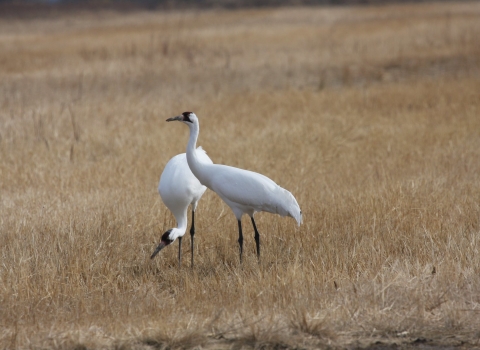Draft Recovery Plan Addendum for Endangered Moloka'i Plant Released for Public Review
A draft Recovery Plan for Phyllostegia hispida - Addendum to the Moloka'i Plant Cluster Recovery Plan - was published today by the U.S. Fish and Wildlife Service. The draft recovery plan identifies recovery actions for the endangered plant Phyllostegia hispida.
Phyllostegia hispida, known only by its scientific name, was designated an endangered species on March 17, 2009. The species is found only in the wet forests of eastern Moloka'i in the Hawaiian Islands.
To prevent the extinction of Phyllostegia hispida and ultimately recover the species within its historical range, the Service recommends: protecting, managing, and increasing all of the known wild populations; continuing survey efforts to identify any additional populations that may exist but are currently unknown; increasing the area occupied by existing populations; establishing new populations; controlling threats such as habitation degradation and predation by feral pigs and competition with invasive introduced plants; and increasing knowledge of the species through research and monitoring to ensure the effective management and reintroduction of the species.
According to the draft recovery plan addendum, Phyllostegia hispida may be considered recovered if a total of 8 to 10 populations are documented on Moloka'i. Each of these populations must be naturally reproducing, stable or increasing in number, and threats must be managed so that a minimum of 300 mature individuals are maintained per population. Each population should persist at this level for a minimum of 5 consecutive years.
Phyllostegia hispida has rarely been seen in the wild. From 1910 to 1979, a total of 8 populations were recorded, but in subsequent years died for various reasons. Since 1996, surveys failed to locate additional individuals and the species was thought to be extirpated until 2005 when two seedlings were discovered at The Nature Conservancy's Kamakou Preserve.
As of 2009, approximately 20 mature individual plants remain in the wild and an unknown number of seedlings. Additional small naturally occurring wild populations containing only seedlings, separate from the 20 mature individuals, are found at the Nature Conservancy's Kamakou Preserve (two populations) and Pu'u Ali'i Natural Area Reserve (one population).
The most significant threat is the species' low numbers, which makes it particularly susceptible to extinction from random events such as hurricanes and disease outbreaks. Other major threats are predation and habitat degradation by feral pigs and competition with invasive, non-native plants.
Conservation measures have been taken and continue today to protect the species. A variety of organizations such as the University of Hawai'i's Lyon Arboretum on O'ahu, the National Tropical Botanical Garden on Kaua'i, Olinda Rare Plant Facility on Maui, and Kalaupapa National Historical Park on Moloka'i are propagating plants that may be used for outplanting into suitable habitat. Land managers from Hawai'i's Department of Land and Natural Resources have fenced some plants to protect them from feral ungulates, and The Nature Conservancy continues to control feral pigs and non-native plants within the Kamakou Preserve.
Phyllostegia hispida is a nonaromatic member of the mint family (Lamiaceae). It is a loosely spreading, many-branched vine that often forms large tangled masses, and is known only from the wet forests of eastern Moloka'i at elevations between 3,650 and 4,200 feet.
The availability of the draft revised recovery plan for a 60-day public comment period was announced in the Federal Register on June 2, 2011. Copies of the draft recovery plan are available through the U.S. Fish and Wildlife Service's website at http://www.fws.gov/pacificislands/ or by calling the U.S. Fish and Wildlife Service's Honolulu office at 808 792 9400. Written comments may be submitted until August 1, 2011 to Loyal Mehrhoff, Field Supervisor, Pacific Islands Fish and Wildlife Office, 300 Ala Moana Boulevard, Room 3-122, Box 50088, Honolulu, Hawai'i 96850.
Phyllostegia hispida, known only by its scientific name, was designated an endangered species on March 17, 2009. The species is found only in the wet forests of eastern Moloka'i in the Hawaiian Islands.
To prevent the extinction of Phyllostegia hispida and ultimately recover the species within its historical range, the Service recommends: protecting, managing, and increasing all of the known wild populations; continuing survey efforts to identify any additional populations that may exist but are currently unknown; increasing the area occupied by existing populations; establishing new populations; controlling threats such as habitation degradation and predation by feral pigs and competition with invasive introduced plants; and increasing knowledge of the species through research and monitoring to ensure the effective management and reintroduction of the species.
According to the draft recovery plan addendum, Phyllostegia hispida may be considered recovered if a total of 8 to 10 populations are documented on Moloka'i. Each of these populations must be naturally reproducing, stable or increasing in number, and threats must be managed so that a minimum of 300 mature individuals are maintained per population. Each population should persist at this level for a minimum of 5 consecutive years.
Phyllostegia hispida has rarely been seen in the wild. From 1910 to 1979, a total of 8 populations were recorded, but in subsequent years died for various reasons. Since 1996, surveys failed to locate additional individuals and the species was thought to be extirpated until 2005 when two seedlings were discovered at The Nature Conservancy's Kamakou Preserve.
As of 2009, approximately 20 mature individual plants remain in the wild and an unknown number of seedlings. Additional small naturally occurring wild populations containing only seedlings, separate from the 20 mature individuals, are found at the Nature Conservancy's Kamakou Preserve (two populations) and Pu'u Ali'i Natural Area Reserve (one population).
The most significant threat is the species' low numbers, which makes it particularly susceptible to extinction from random events such as hurricanes and disease outbreaks. Other major threats are predation and habitat degradation by feral pigs and competition with invasive, non-native plants.
Conservation measures have been taken and continue today to protect the species. A variety of organizations such as the University of Hawai'i's Lyon Arboretum on O'ahu, the National Tropical Botanical Garden on Kaua'i, Olinda Rare Plant Facility on Maui, and Kalaupapa National Historical Park on Moloka'i are propagating plants that may be used for outplanting into suitable habitat. Land managers from Hawai'i's Department of Land and Natural Resources have fenced some plants to protect them from feral ungulates, and The Nature Conservancy continues to control feral pigs and non-native plants within the Kamakou Preserve.
Phyllostegia hispida is a nonaromatic member of the mint family (Lamiaceae). It is a loosely spreading, many-branched vine that often forms large tangled masses, and is known only from the wet forests of eastern Moloka'i at elevations between 3,650 and 4,200 feet.
The availability of the draft revised recovery plan for a 60-day public comment period was announced in the Federal Register on June 2, 2011. Copies of the draft recovery plan are available through the U.S. Fish and Wildlife Service's website at http://www.fws.gov/pacificislands/ or by calling the U.S. Fish and Wildlife Service's Honolulu office at 808 792 9400. Written comments may be submitted until August 1, 2011 to Loyal Mehrhoff, Field Supervisor, Pacific Islands Fish and Wildlife Office, 300 Ala Moana Boulevard, Room 3-122, Box 50088, Honolulu, Hawai'i 96850.


